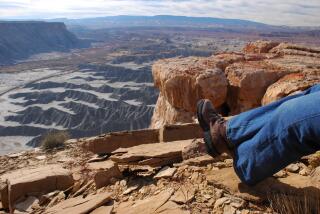A duel in the desert?
Sen. Dianne Feinstein (D-Calif.) has done a lot of admirable work protecting California’s wild desert lands from development, but her latest plans for the Mojave threaten to split the state’s environmental community and could stall clean- energy projects whose construction should be among the nation’s highest priorities.
Feinstein is working on legislation that would designate hundreds of thousands of acres of desert land as a national monument, which would put them off-limits for solar and wind energy projects. That could result in a green- versus-green confrontation, pitting those who want to protect the desert ecosystem against those who believe renewable-energy projects are a vital part of the struggle to avert catastrophic climate change.
But that’s a false dichotomy. According to the U.S. Energy Department, enough sunlight hits a 100-square-mile portion of the Nevada desert to power the entire country, if it could be harnessed. The Southwestern desert is vast, and it should be possible to both protect key habitat for threatened species such as the desert tortoise and build huge solar arrays from California to Colorado.
The desert ecosystem is a terribly fragile one. Though it often looks like nothing is growing there, the desert is actually teeming with life -- life that subsists on a very delicate balance. We strongly support Feinstein’s goal of protecting the desert, within reasonable bounds. Those include a recognition that global warming, if unchecked, will be far worse for all the world’s species than a few solar power plants.
Even more controversial than the siting of renewable-energy projects is the construction of power lines that would be needed to carry the electricity to urban centers. Often, these lines must pass through communities, parks or other wild lands, leading to opposition from residents and conservationists. Builders of these projects must continue to do everything possible to minimize the environmental damage, but state and federal officials should seek to reduce red tape and speed their construction.
We’ll withhold judgment on Feinstein’s monument proposal until she actually produces it -- the senator is still studying which lands to protect in a swath between the Mojave National Preserve and Joshua Tree National Park. The decision-making process presents a welcome opportunity for dialogue about balancing the need for renewable power with the need to conserve sensitive lands.
Yet perhaps it’s possible to love the desert too much; if we go too far in protecting it from solar development, those wide arid spaces promise to become a lot wider in the scorching future.
More to Read
Get the L.A. Times Politics newsletter
Deeply reported insights into legislation, politics and policy from Sacramento, Washington and beyond. In your inbox three times per week.
You may occasionally receive promotional content from the Los Angeles Times.










